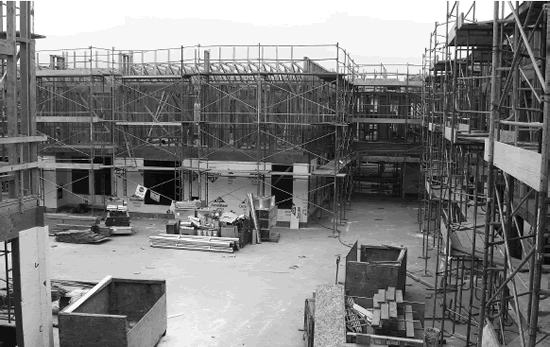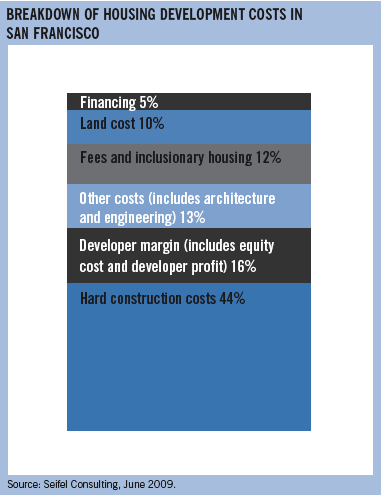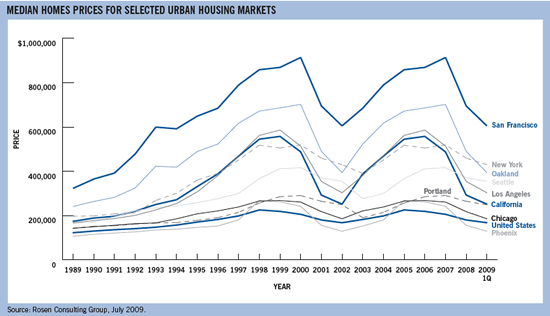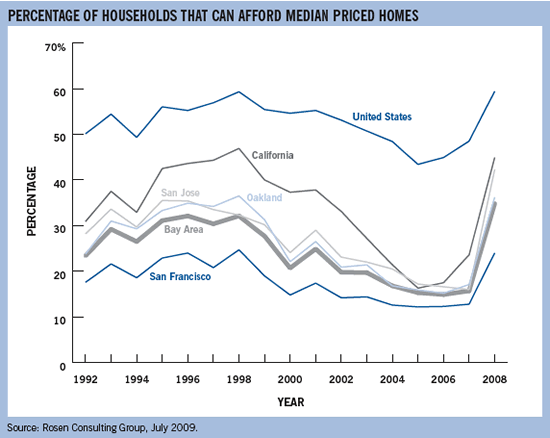
Tassafaronga Village construction, Oakland, CA by David Baker + Partners; Photo by Mark Hogan.
The components of housing price
1. Construction costs: materials, labor, equipment and contractor’s overhead and profit. The cost to build a unit of housing varies by construction type. Single-family tract homes are the cheapest to build, followed by wood-frame apartment buildings, followed by concrete and steel high-rises. Except for different site conditions and union vs. non-union labor considerations, construction costs are similar within the Bay Area since materials, labor and contractor’s profit are comparable across the region. For a given building type, these costs will be similar no matter where one builds, and no matter who is going to live in the unit. Affordable housing does not cost less to build, it’s just that the price paid by the occupants is subsidized.
2. Soft costs: everything else, including design, marketing, financing, legal fees, lobbying, insurance, government fees, etc. Soft costs vary greatly by location. It’s important to remember that developers typically don’t spend a lot of their own money, but instead get investors to put money into a project and borrow a portion of the construction cost from a bank. Developers compete for investment with other investment opportunities: the stock market, tech start-ups, etc. Therefore, the cost to secure equity investors for housing projects is set by competition among investment opportunities across the entire international economy.
Also, regulatory barriers and an unpredictable entitlement process add significantly to the indirect costs. In San Francisco, developers spend a lot of money on lobbying and legal fees to get a project approved. Second, because the approval takes so long, a large amount of money is spent on the carrying costs of land. And because the outcome is so uncertain, the perceived risks to investors are increased, which drives up the rate of return that investors demand. In addition, the up-front costs of unapproved developments must be recouped by those that are approved.
3. Land costs also vary widely between locations. For example, land values in the South Beach neighborhood of San Francisco are much higher than in Oakland or Tracy. Raw land prices are determined by how much revenue a piece of land would generate if it were developed at its most profitable use, subtracting the costs of development.
Rezoning a piece of land from single-family homes to apartment buildings usually increases the land price because it means that more housing units — and hence more revenue — can be earned from the same piece of land. On the other hand, demand for the uses that could theoretically go on a piece of land is much higher in some places than others. And the same house can be sold for much more money in a walkable, high-amenity urban area close to employment and street life than it could in a distant mono-cultural suburb.
Because a developer can sell the same housing units for more money in a walkable urban neighborhood of San Francisco and because there are many other valuable uses to which central city land can be put, land owners in those neighborhoods can charge developers extremely high prices when a developer buys a parcel. Thus, the cost of land is not what pushes housing prices in San Francisco so high. Rather, it’s the high demand for housing.

home prices and problems of affordability
Overall, California’s median home price has fallen at a much faster rate than the national median price during the housing market correction. The state’s median price of $251,660 in the first quarter of 2009 was 50 percent higher than the national median price, compared with a peak gap of 175 percent in April 2007. Since 1980, California’s median home price has been approximately 80 percent higher than the national median price on average.

San Francisco, one of the most expensive housing markets in the country, was more than double the California median price in the first quarter and more than 350 percent above the national average. However, San Francisco is somewhat insulated from a drastic reduction in prices because the City has a relatively diverse economic base, low levels of foreclosures and the market did not exhibit the exorbitant run-up in prices that other “hot” Western markets did during the boom. However, job losses and the severe recession are eroding prices.
On a national level, the foreclosure tsunami is pushing house prices down, particularly for lower priced homes. In California, for example, real estate-owned (REO) properties dominate sales, accounting for 55 percent of the total. The lion’s share of these distressed properties is located in the Central Valley and parts of Southern California. The current home price series includes the impact of REO sales to varying degrees across the country, making it difficult to assess where prices will land once the wave subsides.
The Bay Area, especially San Francisco, is one of the least affordable markets in the country. In the recent housing boom, the percentage of households able to afford a median-priced home dropped to record low levels, reaching the low-teens for San Francisco and the mid-teens for the Bay Area in 2005 and 2006, as robust home price appreciation and easy credit pushed affordability levels to unsustainable lows. However, with the drop in house prices and low mortgage rates, affordability has improved to 24 percent at year-end 2008 in San Francisco and 35 percent in the Bay Area. Given the further deterioration in prices through the first half of 2009, we believe affordability rates have crept up even higher.

